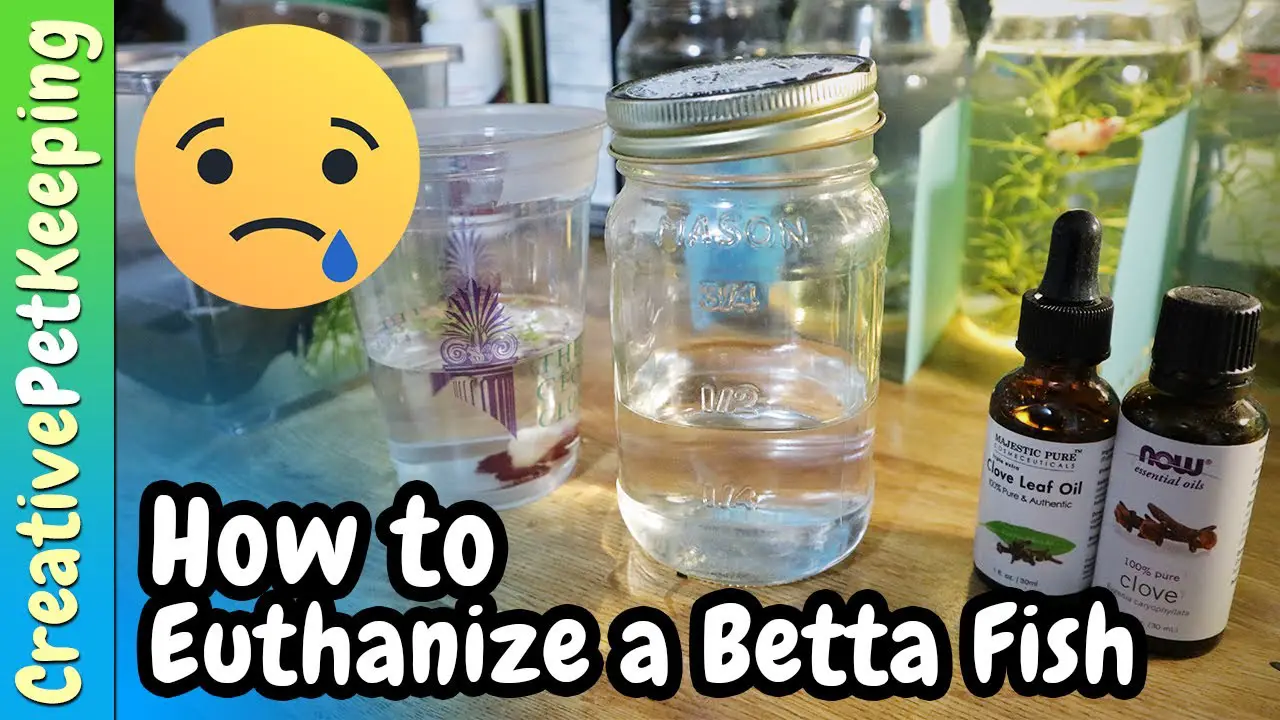Betta fish are often seen as low-maintenance pets due to their small size and easy care. However, sometimes these beloved fish may become sick or injured to the point where euthanasia is the most humane option. While clove oil is a commonly used method for euthanizing betta fish, not everyone has access to it or may prefer to use alternative methods. In this article, we will explore how to euthanize a betta fish without using clove oil.
It’s never easy to say goodbye to a beloved pet, but it’s important to ensure their passing is as comfortable and painless as possible. Whether you’re dealing with a betta fish that is suffering from a terminal illness or a serious injury, knowing how to properly euthanize them is crucial. In this guide, we will go over some alternative methods for euthanizing betta fish that don’t involve the use of clove oil, allowing you to say goodbye to your fish in the most humane way possible.
How to Euthanize a Betta Fish Without Clove Oil?
If you are looking for a way to euthanize your betta fish without using clove oil, the most humane method is to use an overdose of anesthetic. You can get anesthetic from your local vet or pet store. Simply add the anesthetic to your betta’s water, following the instructions on the label, until your betta falls asleep and stops breathing. It is important to remember that euthanizing a pet is a serious decision, and you should always do what is best for your betta’s well-being.

How to Euthanize a Betta Fish Without Clove Oil?
Betta fish, also known as Siamese fighting fish, are popular pets due to their colorful appearance and low-maintenance care. However, there may come a time when a betta fish becomes ill or injured beyond repair, and euthanasia is the most humane option. While clove oil is a commonly recommended method for euthanizing betta fish, it may not be readily available or feasible for some fish owners. In this article, we will discuss alternative methods for euthanizing a betta fish without using clove oil.
1. Freezing Method
The freezing method is a commonly used method for euthanizing fish. To perform this method, place your betta fish in a small plastic bag with some water, and then place the bag in the freezer. The cold temperature will slowly lower the fish’s metabolism, causing it to become unconscious and eventually pass away.
It is important to note that this method may take several hours, and it is not an instant process. Additionally, it is crucial to ensure that the fish is not exposed to any air during the process, as this can cause unnecessary stress and discomfort.
2. Blunt Force Trauma Method
The blunt force trauma method involves quickly and painlessly ending the fish’s life by delivering a sharp blow to its head. To perform this method, place your betta fish on a flat surface, hold its head firmly with one hand, and quickly strike its head with a blunt object, such as a hammer or the back of a spoon.
It is important to note that this method requires a steady hand and precision to ensure that the blow is delivered quickly and effectively. Furthermore, it is crucial to ensure that the fish is completely unconscious before proceeding with the method.
3. Carbon Dioxide Method
The carbon dioxide method involves placing your betta fish in a container filled with carbon dioxide gas, which will cause it to become unconscious and eventually pass away. To perform this method, place your fish in a small container with a lid, and then add some baking soda and vinegar to the container. The reaction between the two substances will produce carbon dioxide gas, which will slowly fill the container and euthanize the fish.
It is important to note that this method may take several minutes, and it is crucial to ensure that the container is airtight to prevent any air from entering. Additionally, it is recommended to use a larger container to ensure that the fish has enough space to move and breathe during the process.
4. Alcohol Method
The alcohol method involves using alcohol to quickly and painlessly euthanize the fish. To perform this method, place your betta fish in a small container with some high-proof alcohol, such as vodka or gin. The alcohol will quickly enter the fish’s bloodstream and cause it to become unconscious and eventually pass away.
It is important to note that this method should only be used as a last resort, as it may cause unnecessary stress and discomfort to the fish. Additionally, it is crucial to ensure that the container is airtight to prevent any air from entering.
5. Benefits and Vs
Each of the methods discussed above has its own benefits and drawbacks. The freezing method is a simple and easy method that does not require any special tools or equipment, but it may take several hours to complete. The blunt force trauma method is a quick and effective method, but it requires precision and may be difficult for some fish owners to perform. The carbon dioxide method is a humane and painless method, but it requires special equipment and may take several minutes to complete. The alcohol method is a quick and effective method, but it should only be used as a last resort and may cause unnecessary stress and discomfort to the fish.
In conclusion, while clove oil is a commonly recommended method for euthanizing betta fish, there are alternative methods available for fish owners who do not have access to clove oil or prefer not to use it. It is important to choose a method that is humane, painless, and effective, and to ensure that the fish is not subjected to any unnecessary stress or discomfort during the process.
Frequently Asked Questions
As a professional writer, I understand that pet owners may need to euthanize their betta fish due to various reasons. Some may not have access to clove oil or may prefer not to use it. Here are some frequently asked questions about euthanizing a betta fish without clove oil:
What are some alternative methods to euthanize a betta fish without clove oil?
One alternative method is using carbon dioxide (CO2) to euthanize a betta fish. This can be achieved by placing the fish in a container with water and adding baking soda and vinegar, which will produce CO2. The fish will gradually lose consciousness and eventually pass away peacefully.
Another method is freezing. This involves placing the fish in a container of water and slowly lowering the temperature until the water is frozen. This method is considered more humane than simply flushing the fish down the toilet.
How do I know when it is time to euthanize my betta fish?
There are several signs that may indicate it is time to euthanize your betta fish. These include lethargy, loss of appetite, difficulty swimming, and visible signs of illness or injury. If your fish is suffering and unable to recover, it may be time to consider euthanasia.
It is important to consult with a veterinarian or experienced fish keeper before making the decision to euthanize your betta fish.
Is it possible to euthanize a betta fish without causing it any pain?
Euthanasia should always be carried out in the most humane way possible to minimize pain and suffering. While some methods may cause discomfort initially, they should ultimately result in a peaceful passing. It is important to follow the instructions carefully and ensure that the fish is fully anesthetized or unconscious before proceeding with the euthanasia method.
It is also important to remember that euthanasia should only be considered as a last resort when all other options have been exhausted and the fish is suffering and unable to recover.
What should I do with my betta fish’s remains after euthanasia?
After euthanasia, it is important to dispose of your betta fish’s remains in a respectful and environmentally responsible manner. Flushing the fish down the toilet is not recommended as it can be harmful to the environment. Instead, you can bury the fish in your backyard or dispose of it in the trash, wrapped securely in a plastic bag.
If you prefer a more eco-friendly option, you can also consider cremation or burial at a pet cemetery.
Can I use over-the-counter euthanasia products for my betta fish?
While there are some over-the-counter euthanasia products available for fish, they may not be effective or humane. It is important to consult with a veterinarian or experienced fish keeper before using any products to ensure that the fish is euthanized in the most humane way possible.
Using improper euthanasia methods can cause unnecessary pain and suffering to the fish, which goes against the ethical treatment of animals. It is important to always prioritize the well-being of your betta fish in any end-of-life decisions.

How To Humanely Euthanize a Betta Fish at Home
In conclusion, euthanizing a betta fish is a difficult decision that many pet owners may have to face. While clove oil is a popular and humane method, there are alternative ways to put your betta fish to rest.
One option is to use baking soda and water to create a solution that will quickly and painlessly euthanize your fish. Another option is to use vodka or other high-proof alcohol to sedate and then euthanize your fish.
Regardless of which method you choose, it’s important to remember that euthanizing a pet should always be done with care and compassion. Take the time to ensure that your betta fish is comfortable and peaceful in their final moments, and seek support from a veterinarian or animal welfare organization if needed.
